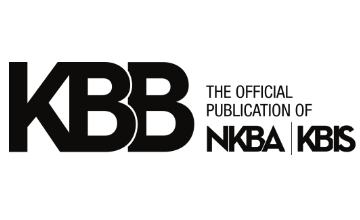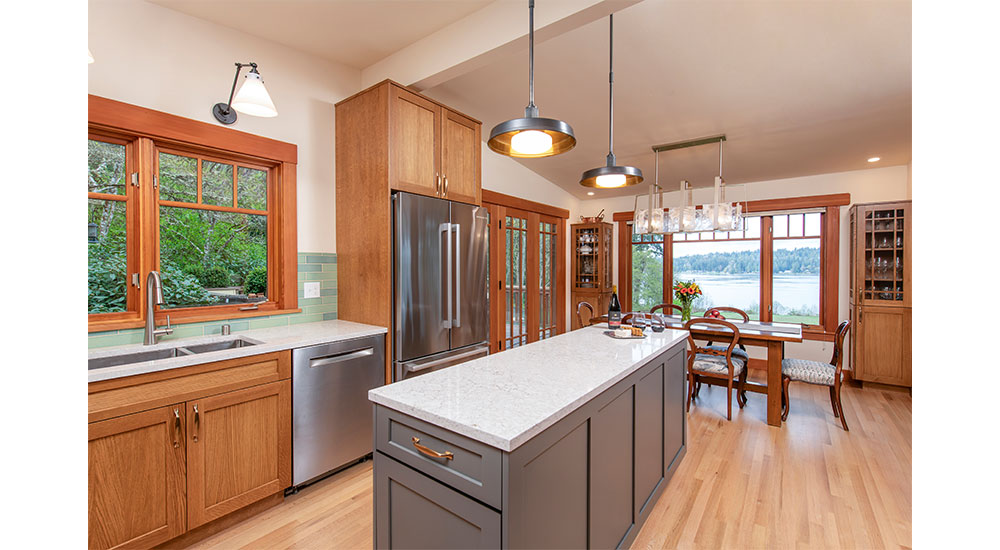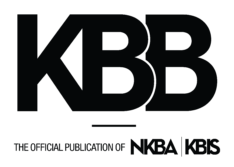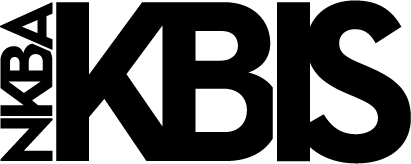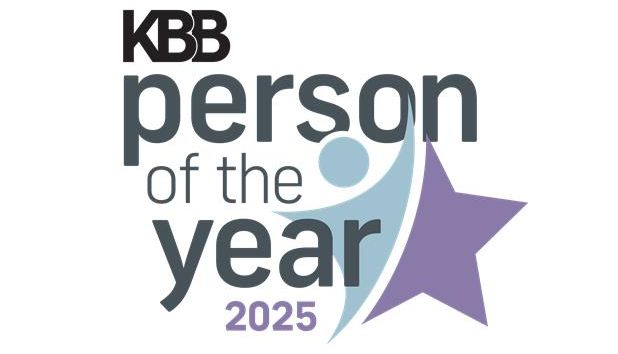Today’s Cabinetry and Storage Trends
Today’s cabinetry and storage trends abounded in a plethora of colors and finishes at KBIS 2025; thank goodness homeowners today are taking a step beyond white with bolder hues and stains. Storage features ran the gamut, and one designer on his first trip to KBIS told us paper towel innovation was all the rage this year. Clients truly want a place for everything and everything in its place.
In our most recent survey, more than 200 industry experts shared their thoughts on today’s cabinetry and storage trends and needs. Read on to find out more about preferred colors, finishes and design details, as well as features that cater to convenience and accessibility.
Above photo: This kitchen designed by Molly McCabe, AKBD, CLIPP, CGP, owner and principal designer of McCabe by Design LLC, features Dura Supreme quarter-sawn white oak cabinetry with the Carson door/drawer style. The mantle hood is also from Dura Supreme. Photo credit: Iklil Gregg Photography
Getting the Look in Shades & Finishes
Although there has been a movement away from white cabinetry for some, it was still noted as the most popular color for kitchen projects in the last year at 43.2%. Coming in second was “other” choices, and the write-in answers included natural wood (white oak especially), beige or cream (I still consider those white), greige, purple and brown. Coming in at the bottom the color wheel in this year’s survey were green, gray, blue and black.
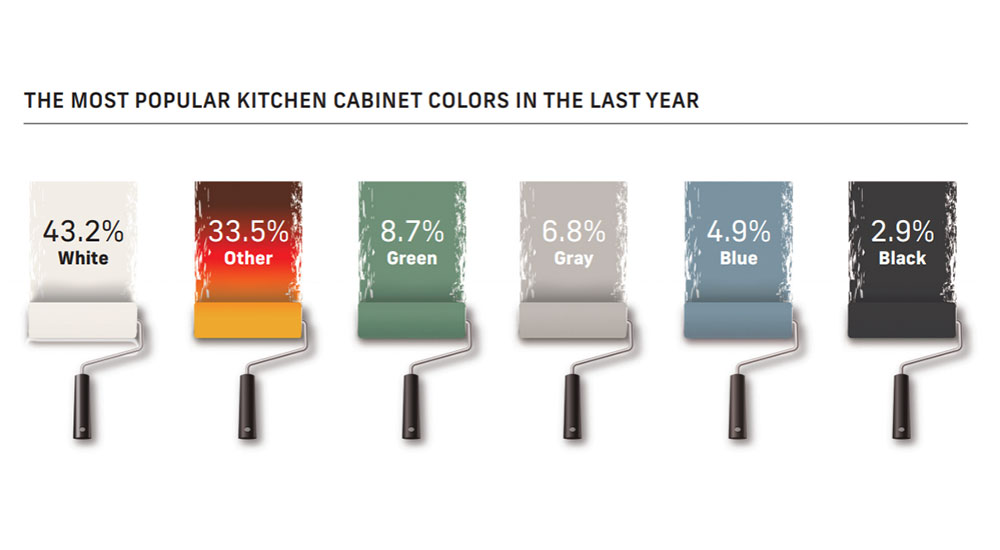
Photo credit: Vitaliy – stock.adobe.com
“White is definitely waning, but I am receiving more requests for dual-finish cabinetry packages in kitchens and laundry rooms, i.e., wood bases/island and painted uppers or perimeters,” said Molly McCabe, AKBD, CGP, CAPS, CLIPP, principal designer at McCabe by Design, Bainbridge Island, Wash. “Bathrooms and closets are typically one finish/species.”
In terms of cabinet finishes for kitchens and baths, painted was number one at 57.1%, and stained came in second with just 14.1%. At the bottom of the list were natural, laminate, veneer, glaze, powder coat/varnish and Thermofoil finishes. Write-in answers included lacquer and a combination of paint and stain or natural wood.
“Most of our clients are still asking for painted cabinets, and we are still doing a lot of two-toned kitchens with either a combination of two paint colors or some painted and some stained,” said Kim Anderson, a designer with Delafield, Wis.-based Kowalske Kitchen & Bath. “On occasion, I will have someone asking for all stained cabinetry.”
All in the Details
Fluted, grooved and reeded were the buzzwords when it came to cabinetry detail at KBIS. Those terms came into play for countertops, hardware and plumbing fixtures as well. Our survey indicates that it hadn’t quite taken off for kitchen and bath projects completed in the last year, as our respondents said 44.1% of theirs did not include that particular detail, and 38.2% only used it in 1-24% of their projects.
Anderson and McCabe say their clients love the look of more texture, but they are concerned with the upkeep of keeping the grooves clean. The reeding can be a more expensive option, and mounting hardware to a fluted surface may have its challenges.
Modular cabinetry was also a trend seen and discussed at KBIS, but that too is taking some time to catch on. A third of our respondents said they did not use modular options in any of their kitchen and bath projects during the last 12 months, and only 19.5% said they used it in all projects.
“Entry-level, production-built homes – both single- and multi-family – are suited to modular cabinetry because of cost and lead times,” said McCabe. “It is not so much for the mid- to upper-end remodels because there is not enough customization.”

The cabinetry in this bathroom designed by Monica Boldea of Kowalske Kitchen & Bath is a stylish blend of form and function: Jewel-toned cabinets contrast against warm white oak. Smart storage solutions include U-shaped sink drawers, a tilt-out laundry basket cabinet and a tall linen cabinet. Photo credit: Kyleen Dzploch Photography
Cabinetry Conveniences
Topping the list for ease-of-use features specified in kitchen cabinets over the last year are drawer inserts-dividers, and coming in at a close second is blind-corner storage. Pantries/larders are still in demand at 66.7%, as is manual or motorized adjustable storage at 61.8%. Beverage centers, device-charging stations, hidden outlets and push-to-open drawers and doors round out the list of most popular convenience features in today’s kitchen cabinets. Write-in answers included paper towel storage, trash/compost pullouts, toe kick storage and partitions over the fridge for baking pans and cookie sheets.
As far as storage specifics that make life easier in the bathroom, linen storage topped the list at 70.4%, and medicine cabinet storage, in-vanity/drawer outlets and drawer inserts/dividers came in at the second, third and fourth most-popular choices. A lot of homeowners still want built-in hampers and manual or motorized adjustable storage, but less are asking for securable storage in the bath. Other answers included U-shape sink drawers, waste basket storage and powered grooming stations.
Accessible Options
Design for living and aging in place is actually becoming the “it” thing to do. Homeowners understand that accessible spaces do not necessarily need to be for a certain age group or a person with specific needs – they can really be for anyone.
Drawers versus doors in kitchens and baths took the top spot on top accessible options over the last year. Lever/pull cabinet handles came in second in baths and third in kitchens; open shelving took third place in bathrooms and second in kitchens. Other popular accessible options included wheelchair-accessible sink cabinetry, push-to-open doors and drawers, pulldown/pullout storage, in-cabinet/drawer lighting and reduced-height base cabinets. Write-in choices were toe kick step stool storage and hands-free options.
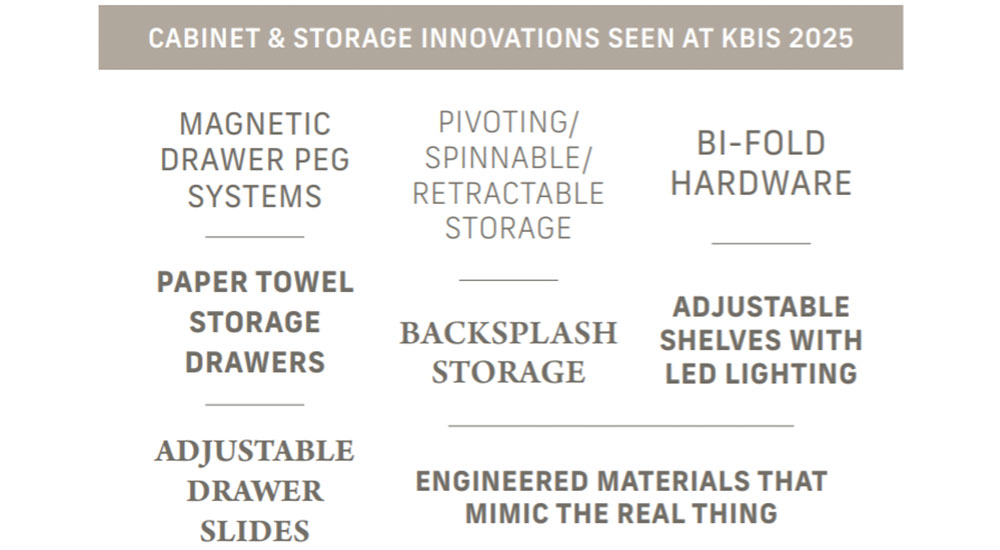
Today’s Cabinetry and Storage Trends: Ingenious Innovation
Respondents shared with us what cabinetry and storage advancements they have seen at KBIS 2025 and other industry shows, citing things like mixed materials (think metal and concrete) and the return of the pullout bread board in the kitchen.
Specific product innovations included the magnetic peg system in drawers, swing-up hinge mechanisms, adjustable drawer slides, spinnable/retractable storage, rechargeable LED-lighted drawers and shelves, hidden storage behind the backsplash and motion sensors in toe kicks.
In terms of cabinetry aesthetics, engineered materials that mimic natural finishes are gaining traction, as are bi-fold or sliding doors in kitchen islands or wall cabinets.
Anderson noted the cabinetry with metal trim and stepladder pullout storage seen at KBIS 2025. McCabe noted rattan cabinets doors and a new pop-up power tower for the countertop, which may be required by code in the future.
“In our jurisdiction, they have adopted the rule that there are to be no outlets on the sides of cabinets, islands or peninsulas,” said McCabe, who said she has been using docking stations in drawers to mitigate this potential issue.
Tariff Turmoil
In our survey, we asked if the proposed tariffs are having an impact on the cabinet selection for kitchen and bath projects. Although most said they are not seeing much just yet, a lot are preparing for what could come.
Buying USA-made products was a popular solution, and many said they would be forced to implement price increases as needed, letting clients know up front. Others are asking manufacturers to secure a contract price, comparing prices from different companies and keeping common items in stock.
One respondent said they have offset some of the increased costs by offering additional discounts on other items like cabinet handles and sinks. Another suggested reducing and reusing; use local talent to build new cabinets out of the old and upgrade existing cabinets. One industry expert has added potential additional cost to proposals, if the tariffs don’t go through, they will give their clients a credit.
As is common in our resilient industry, design and construction professionals – as well as cabinet shops and brands – are pivoting through potential challenges. Only time will tell what solutions we come up with next.
